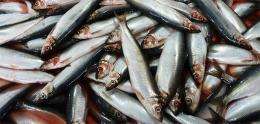Herring can give us even more food

Herring is one of the most common table fish in the entire world, but large parts of the catch is being used for fish feed. "From an environmental perspective, it is better if the herring is used for food for humans," says Chalmers researcher Sofia Marmon. She has succeeded in extracting fish proteins from herring, which can be used for new foodstuffs. In addition, the dioxin content decreases.
Sofia Marmon recently defended her PhD thesis at Chalmers University of Technology. She has succeeded in making use of the proteins in herring, using a method that is known as the pH-shift process. The aim is to extract the proteins from raw materials that are not used as food for human consumption today. In addition to herring that is used for fishmeal production, other poorly consumed small fish species can be used, such as Anchoveta and European sprat, or the muscle-rich backbones that are left over when fish are filleted.
“Fish fillets have been used in most previous experiments where the pH-shift process has been employed, but I think that fish fillets should instead be eaten as they are”, says Sofia Marmon.
The method of extracting proteins used by Sofia Marmon was invented at the end of the 1990s at the University of Massachusetts. Sofia Marmon’s tutor, Professor Ingrid Undeland, was one of the researchers there and she then brought the method to Chalmers.
The structure of the muscle protein isolate that is extracted through the pH-shift process resembles a paste with quite a high water content. The consistency of the proteins is moldable and they can therefore be used as an ingredient in various products, or for developing entirely new foodstuffs.
The pH-shift process has already started to be used in production in the USA and Iceland. The company in the USA uses the extracted proteins as a replacement for breadcrumbs in the coating of fried products. The advantage is that the proteins protect the fish better towards moisture loss during the frying, at the same time as it absorbs less fat.
Sofia Marmon’s research shows that the extracted proteins have a good nutritional value and are a lot purer than in the raw product. Both skin and bone are removed and the fat content is lowered. This means that fat-soluble toxins are also removed, such as PCB and harmful dioxins, which can be found for example in the herring in the Baltic Sea. Sofia Marmon has also shown, using a test tube model, that the extracted fish proteins can easily be digested in the stomach and intestinal tract.
Sofia Marmon thinks that in order for the process to be used more commercially, the industry must have enough believe in its potential to make the necessary investments.
“It’s time to move onto product development. Of course we as scientists can play an important role here in providing background information and also help out during up-scaling. I hope that this becomes a product that people are well aware of and have confidence in. In order to avoid any misconceptions, it is important that the industry is open and clearly declares what the new product consists of. We do not want to have a situation where people think that a new ingredient has been added surreptitiously.”
Naturally, Sofia Marmon has tasted the purified proteins extracted from herring, which after heat treatment have a consistency similar to crabsticks.
“It didn’t taste or smell of much. You have to use spices to make it tasty.”
More about: How the pH-shift process works
The herring is ground and mixed with water. An acid or base is added in order to adjust the pH value. When the pH value decreases or increases, the proteins become electrically charged and repel each other. The proteins open up and attract more water. When most of the fish’s proteins are water-soluble, they can be separated from the non-soluble unwanted parts by centrifugation. Most of the fish fat can also be removed. Once the pH value of the water solution has been readjusted so that the protein solubility is minimal, the proteins can be collected by a second centrifugation.
More about: Herring and the environment
From a resource perspective, it is better to eat fish, such as herring and European sprat, than manufacture fish meal, which is then used for feed in fish farming and in chicken and pig breeding.This is mainly due to the fact that only a small part of the energy is transferred from one stage of the food chain to the next. In all animals, most of the food is used for “fuel”. Only 5 - 25 per cent of the food forms “building blocks” in the body and, consequently, food for the next consumer in the food chain.
Herring is one of the more sustainable fish species and is one of the most common fish species in the world. Last year, 2.5 million tonnes of herring were caught worldwide. However, a large proportion of the total catch is being used for things other than food for human consumption, such as fish feed. The same scenario is seen for many other small pelagic fish species; large quantities are caught but the catches are mostly used for fishmeal production.
More information: Read the thesis Protein isolation from herring (Clupea harengus) using the pH-shift process - Protein yield, protein isolate quality and removal of food contaminants
Provided by Chalmers University of Technology


















